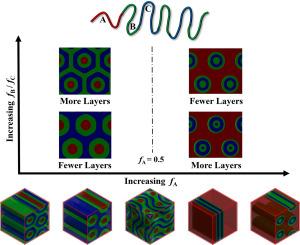体积分数对A(BC)2B多嵌段共聚物分层结构的影响:在高性能复合材料设计中的辅助作用
IF 7.7
2区 材料科学
Q1 MATERIALS SCIENCE, COMPOSITES
引用次数: 0
摘要
利用自一致场理论研究了体积分数对A(BC)2B多嵌段共聚物中层次结构的影响,以帮助设计高性能聚合物基复合材料。长尾A块体fA的体积分数对大尺度结构影响很大。例如,在低χBCN时,增加fA可以观察到C5→C3→G5→L5→C5¯的过渡序列。此外,A体积分数也会影响小尺度结构,其中大fA更倾向于具有较少中薄层的分层结构。随后,我们探索了fB/fC比对分层结构稳定性的影响,其中fB/fC比大导致分层层片和分层柱在大fA>;0.5时的中薄层较少的分层结构。有趣的是,对于fA<;0.5的分层圆柱体,较大的fB块导致分层圆柱体具有更中薄的层。本文章由计算机程序翻译,如有差异,请以英文原文为准。

Effect of volume fraction on the hierarchical structures in A(BC)2B multiblock copolymers: Assisting in the design of high-performance composites
We study the effect of volume fraction on the hierarchical structures in the A(BC)2B multiblock copolymers using the self-consistent field theory to assist in the design of high performance polymer-based composites. The volume fraction of long-tail A block greatly impacts on the large-scale structures. For example, a transition sequence of at low is observed by increasing . In addition, the A volume fraction can also affect small-scale structures, where large prefers hierarchical structures with fewer mid-thin layers. Subsequently, we explore the effect of the ratio on the stability of the hierarchical structure, where a large ratio leads to the hierarchical structures with less mid-thin layer for the hierarchical lamellae and hierarchical cylinder at large . Interestingly, for the hierarchical cylinder with , a large block results in the hierarchical cylinder with a more mid-thin layer.
求助全文
通过发布文献求助,成功后即可免费获取论文全文。
去求助
来源期刊

Composites Communications
Materials Science-Ceramics and Composites
CiteScore
12.10
自引率
10.00%
发文量
340
审稿时长
36 days
期刊介绍:
Composites Communications (Compos. Commun.) is a peer-reviewed journal publishing short communications and letters on the latest advances in composites science and technology. With a rapid review and publication process, its goal is to disseminate new knowledge promptly within the composites community. The journal welcomes manuscripts presenting creative concepts and new findings in design, state-of-the-art approaches in processing, synthesis, characterization, and mechanics modeling. In addition to traditional fiber-/particulate-reinforced engineering composites, it encourages submissions on composites with exceptional physical, mechanical, and fracture properties, as well as those with unique functions and significant application potential. This includes biomimetic and bio-inspired composites for biomedical applications, functional nano-composites for thermal management and energy applications, and composites designed for extreme service environments.
 求助内容:
求助内容: 应助结果提醒方式:
应助结果提醒方式:


